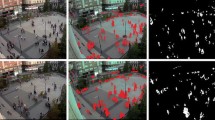Abstract
This paper investigates sub-integer implementations of the adaptive Gaussian mixture model (GMM) for background/foreground segmentation to allow the deployment of the method on low cost/low power processors that lack Floating Point Unit. We propose two novel integer computer arithmetic techniques to update Gaussian parameters. Specifically, the mean value and the variance of each Gaussian are updated by a redefined and generalized “round” operation that emulates the original updating rules for a large set of learning rates. Weights are represented by counters that are updated following stochastic rules to allow a wider range of learning rates and the weight trend is approximated by a line or a staircase. We demonstrate that the memory footprint and computational cost of GMM are significantly reduced, without significantly affecting the performance of background/foreground segmentation.
















Similar content being viewed by others
References
Apewokin, S., Valentine, B., Forsthoefel, D., Wills, L., Wills, S., Gentile, A.: Embedded real-time surveillance using multimodal mean background modeling. In: Kisaanin, B., Bhattacharyya, SS., Chai, S. (eds.) Embedded Computer Vision, Advances in Pattern Recognition, pp. 163–175. Springer, London (2009)
Ben Tan, L.W.; Junping, Z.: Semi-supervised elastic net for pedestrian counting. Patt. Recogn. (2011)
Candes, E., Romberg, J., Tao, T.: Robust uncertainty principles: exact signal reconstruction from highly incomplete frequency information. Info. Theory IEEE Trans. 52(2), 489–509 (2006). doi:10.1109/TIT.2005.862083
Cheung, S.C.S., Kamath, C.: Robust techniques for background subtraction in urban traffic video. SPIE, 5308:881–892 (2004). doi:10.1117/12.526886
Cucchiara, R., Grana, C., Piccardi, M., Prati, A.: Detecting moving objects, ghosts, and shadows in video streams. Patt. Anal. Mach. Intell. IEEE Trans. 25(10), 1337–1342 (2003). doi:10.1109/TPAMI.2003.1233909
Debian project Raspbian. http://www.raspbian.org/ (2012)
Donoho, D.: Compressed sensing. Info. Theory IEEE Trans. 52(4),1289–1306 (2006). doi:10.1109/TIT.2006.871582
Elia, M., Neri, F.: Generation of pseudorandom independent sequences. In: IASTED International Symposium MIC ’86 (1986)
Hung, M.H., Pan, J.S., Hsieh, C.H.: Speed up temporal median filter for background subtraction. In: Proceedings of the 2010 First International Conference on Pervasive Computing, Signal Processing and Applications, IEEE Computer Society, Washington, DC, USA, PCSPA ’10, pp. 297–300. doi:10.1109/PCSPA.2010.79 (2010)
Hwang, Y., Kim, J.S., Kweon, I.S.: Sensor noise modeling using the skellam distribution: Application to the color edge detection. In: Computer Vision and Pattern Recognition, 2007. CVPR ’07. IEEE Conference on, pp. 1–8. doi:10.1109/CVPR.2007.383004 (2007)
Iannizzotto, G., La Rosa, F., Lo Bello, L.: A wireless sensor network for distributed autonomous traffc monitoring. In: Human System Interactions (HSI), 2010 3rd Conference on, pp. 612–619. doi:10.1109/HSI.2010.5514504 (2010)
Lo, B., Velastin, S.: Automatic congestion detection system for underground platforms. In: Intelligent Multimedia, Video and Speech Processing, 2001. Proceedings of 2001 International Symposium on, pp. 158–161. doi: 10.1109/ISIMP.2001.925356 (2001)
McFarlane, N.J.B., Schofield, C.P.: Segmentation and tracking of piglets in images. Mach. Vision Appl. 8(3), 187–193 (1995). doi:10.1007/BF01215814
Microchip PIC32MX3XX/4XX Family Data Sheet. http://www.microchip.com (2008)
Pagano, P., Salvadori, C., Madeo, S., Petracca, M., Bocchino, S., Alessandrelli, D., Azzar, A., Ghibaudi, M., Pellerano, G., Pelliccia, R.: A middleware of things for supporting distributed vision applications. In: Proceedings of the 1st Workshop on Smart Cameras for Robotic Applications (SCaBot) (2012)
Piccardi, M.: Background subtraction techniques: a review. In: Systems, Man and Cybernetics, 2004 IEEE International Conference on, vol. 4, pp. 3099–3104. doi:10.1109/ICSMC.2004.1400815 (2004)
Radke, R.J., Andra, S., Al-Kofahi, O,, Roysam, B.: Image change detection algorithms: a systematic survey. IEEE Trans. Image Proc. 14:294–307 (2005)
Rahimi, M., Baer, R., Iroezi, O.I., Garcia, J.C., Warrior, J., Estrin, D., Srivastava, M.: Cyclops: In situ image sensing and interpretation in wireless sensor networks. In: In SenSys, ACM Press, pp. 192–204 (2005)
Raspberry Pi Foundation (2011) Raspberry Pi BOARD. http://www.raspberrypi.org/
Salvadori, C., Makris, D., Petracca, M., del Rincón, J.M., Velastin, S.A.: Gaussian mixture background modelling optimisation for micro-controllers. In: ISVC (1), pp. 241–251 (2012)
Scuola Superiore Sant’Anna and Evidence srl SEED-EYE BOARD. http://www.evidence.eu.com/products/seed-eye.html (2011)
Shen, Y., Hu, W., Liu, J., Yang, M., Wei, B., Chou, C.: Efficient background subtraction for real-time tracking in embedded camera networks. In: Proceedings of the 10th ACM conference on Embedded Network Sensor Systems (2012)
Stauffer, C., Grimson, W.E.L.: Adaptive background mixture models for real-time tracking. In: Computer Vision and Pattern Recognition, 1999. IEEE Computer Society Conference on., vol 2. doi:10.1109/CVPR.1999.784637 (1999)
Weinland, D., Ronfard, R., Boyer, E.: Free viewpoint action recognition using motion history volumes. Comp Vis Image Understand 104(2–3), 249–257 (2006)
Author information
Authors and Affiliations
Corresponding author
Appendix
Appendix
1.1 Proof from Sect. 3.5.1
A uniformly distributed random number \({\bf X} \in [0, \rm max]\) is characterized by the cumulative distribution function in Eq. 48 and the probability density function in Eq. 49.
On the other hand, if we consider the value P(X n > T X ) and we use the probability properties, the following relation can be obtained:
Rights and permissions
About this article
Cite this article
Salvadori, C., Petracca, M., del Rincon, J.M. et al. An optimisation of Gaussian mixture models for integer processing units. J Real-Time Image Proc 13, 273–289 (2017). https://doi.org/10.1007/s11554-014-0402-5
Received:
Accepted:
Published:
Issue Date:
DOI: https://doi.org/10.1007/s11554-014-0402-5




